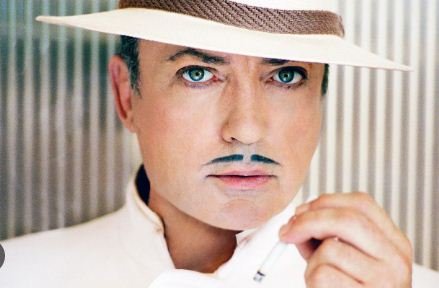Introduction to Udo Kier
Udo Kier is a name synonymous with versatility and longevity in the film industry. Born on October 14, 1944, in Cologne, Germany, Kier has amassed an impressive body of work that has spanned over five decades. His unique talent in portraying a range of characters—from the sinister to the whimsical—has solidified his status as a prominent figure in cinema, both in Europe and Hollywood. Known for his striking features and captivating performances, Kier has appeared in a variety of genres, showcasing his ability to move fluidly between dramatic roles, horror films, and avant-garde projects.
His career began in the late 1960s with key roles in German cinema, swiftly gaining recognition for his work in films like “The Tin Drum” (1979) and “Flesh for Frankenstein” (1973). These early performances captured the attention of auteur filmmakers, including Lars von Trier and Paul Morrissey, who helped define Kier’s path in the realms of art-house and cult cinema. This collaboration allowed him to showcase his range through diverse characters, earning him a loyal fan base and critical acclaim. Kier has also participated in Hollywood blockbusters, demonstrating his global appeal and adaptability.
In recent years, Kier has continued to evolve as an actor, taking on roles in indie films and mainstream projects alike. His appearances in films such as “Melancholia” (2011) and “The Painted Bird” (2019) have reaffirmed his ability to capture the complexities of human experience on screen. Kier remains relevant in contemporary cinema, venturing into collaborations that highlight emerging filmmakers while maintaining a unique artistic vision. His journey illustrates not only his resilience but also his commitment to the craft, making Udo Kier a truly fascinating figure in the world of acting.
Early Life and Hometown
Udo Kier was born on October 14, 1944, in Cologne, Germany. His early life was significantly shaped by the post-World War II environment, which influenced many aspects of his upbringing. Growing up in a war-torn country, Kier experienced the challenges and changes that came with rebuilding a society. His family, consisting of his father, a soldier, and his mother, a homemaker, nurtured his artistic talents from a young age.
As a child, Kier exhibited an interest in theater and performance. He began participating in local plays and school productions, where he honed his craft and discovered a profound passion for acting. This early exposure to the performing arts played a crucial role in shaping his future career. The lively arts scene in Cologne provided a stimulating environment that encouraged young artists like Kier to explore their creativity.
After his family relocated to the small town of Bardenberg, the move further influenced his artistic development. The quaint surroundings and close-knit community gave him ample opportunities for self-expression. Kier’s childhood experiences, marked by both hardship and creativity, instilled in him a desire to tell stories and embody different characters, which later became central to his identity as an actor.
Udo Kier’s formative years laid the foundation for his remarkable career in film and theater. His unique perspective, shaped by the contrasts of his early environment, would eventually help him stand out in a competitive industry. From the humble streets of Cologne to the stages of the world, Kier’s journey as a performer began with a childhood filled with inspiration and ambition, setting the stage for his future accomplishments in the entertainment realm.
Career Beginnings
Udo Kier, an accomplished actor known for his diverse body of work, embarked on his acting career in a rather unconventional manner. Born in Cologne, Germany, his early fascination with the arts led him to pursue a passion for acting following an initial interest in music. Kier’s formative years were marked by a strong engagement in local theater, where he honed his craft and developed a reputation for his compelling performances. His exceptional talent was evident from a young age, often captivating audiences with his intense portrayals.
After completing his formal education, Udo Kier made his mark in the German theater scene during the 1960s, participating in various productions that showcased his range. He caught the attention of critics and audiences alike with his performances in works such as “Hamlet,” showcasing both his dramatic capability and ability to embody complex characters. This exposure ultimately led him to transition from theater to television, where he appeared in several German productions. These roles allowed him to reach a broader audience and laid the groundwork for his entry into the film industry.
Kier’s transition to film was marked by notable appearances in several productions, which further established his foothold in the cinematic landscape. His first major film role came with the 1969 release of “Take Me to the Train,” wherein he demonstrated his versatility as an actor. As the 1970s approached, Udo Kier’s unique look and acting style began to attract the attention of international filmmakers, leading to collaborations that would cement his status in the horror and art film genres. This pivotal shift in his career set the stage for what would become a remarkable journey through the world of cinema.
Famous Movies and Iconic Roles
Udo Kier’s remarkable career spans several decades, marked by a diverse range of roles that have showcased his unique talent and versatility as an actor. One of his most significant films is “Andy Warhol’s Frankenstein” (1973), where Kier played the lead role of the creature, solidifying his status as a prominent figure in the horror genre. This performance not only garnered attention for its provocative take on classic literature but also established a lasting partnership with avant-garde filmmaker, Paul Morrissey.
Another notable film is “Blade: Trinity” (2004), in which Kier portrayed the villainous vampire, Dracula. His commanding presence and captivating performance contributed significantly to the film’s dynamic, positioning him as an unforgettable figure in the action-horror industry. This role, alongside his work in the “Blade” franchise, allowed him to reach a broader audience, proving that his talent transcends genre boundaries.
In Lars von Trier’s “Melancholia” (2011), Kier showcased his ability to adapt to more dramatic and nuanced roles. The poignant film received critical acclaim, and his performance added depth to the overall narrative. Collaborating with prominent directors like von Trier further cemented Kier’s reputation as a serious actor, capable of delivering powerful performances that resonate with audiences. Moreover, he has appeared in films such as “Nymphomaniac” and “The House That Jack Built,” both of which exhibit Kier’s willingness to explore complex characters.
Throughout his career, Udo Kier has not only captivated audiences with his roles but has also established relationships with influential directors, significantly impacting both his trajectory and the films he has worked on. Each performance reinforces Kier’s status as a remarkable actor within the cinematic landscape, making his body of work truly fascinating to explore.
Current Age and Physical Attributes
Udo Kier, born on October 14, 1944, is currently 78 years old. Throughout his extensive career in film and television, Kier has made a strong impression through not only his acting ability but also his distinctive physical attributes. Standing at approximately 6 feet tall, his stature contributes to a commanding presence that often draws the attention of audiences and filmmakers alike. His unique features, such as high cheekbones and a piercing gaze, further enhance his memorable on-screen appearances.
Kier’s striking looks have allowed him to take on a diverse range of roles, from avant-garde films to mainstream productions. Directors often cast him in parts that require a character defined by eccentricity or intensity, attributes that can be linked to his physical stylings. Moreover, his expressive face allows for a wide array of portrayals, whether it be a villain or a tragic figure, thereby solidifying his versatility as an actor. His ability to convey complex emotions through subtle facial expressions has made him an invaluable asset in various genres, lending his characters both depth and authenticity.
Moreover, Udo Kier’s longevity in the industry can also be attributed to his adaptability. Despite the changes in trends and audiences over the years, his originality has kept him in demand, setting him apart from his contemporaries. As he continues to work on new projects, it is evident that both his current age and physical attributes play a crucial role in defining his career and the unique presence he holds in the realm of cinema.
Personal Life and Current Relationship Status
Udo Kier, the renowned German actor, has always been a figure of intrigue, not only for his extensive body of work but also for his approach to personal life. Despite his prominence in the film industry, he has adeptly managed to keep much of his personal affairs private. This choice reflects a conscious decision to maintain a boundary between his public persona and private life, allowing him to navigate fame without losing his sense of self.
As of October 2023, Udo Kier’s current relationship status remains somewhat ambiguous, with little publicly accessible information. This lack of transparency regarding his romantic life has only fueled curiosity among fans and media alike. Kier has historically refrained from sharing details about his partners or personal relationships during interviews, often redirecting conversations back to his work in cinema. This reserved approach not only protects his private matters but also illustrates a desire to be recognized primarily for his contributions to the film industry rather than his romantic entanglements.
Kier’s commitment to privacy is emblematic of his overall philosophy toward fame and success. He believes in the importance of preserving personal space, a sentiment that resonates with many public figures navigating similar challenges. By prioritizing his privacy, Udo Kier has crafted a persona that is both enigmatic and captivating, inviting the audience to focus on his art rather than his personal life. His ability to maintain this balance speaks to his understanding of the entertainment industry and the often-pervasive scrutiny that comes with it.
In conclusion, Udo Kier’s personal life remains largely shielded from the public eye, a testament to his desire for privacy amidst his illustrious career. His relationship status, albeit unclear, exemplifies his chosen approach to fame and highlights the delicate equilibrium he strives to achieve in both spheres of existence.
Awards and Recognition
Udo Kier’s illustrious career has not gone unnoticed in the film industry. Over the years, he has garnered numerous awards and accolades that reflect his exceptional talent and dedication to the craft of acting. His performances across a diverse array of genres have earned him a respected place in cinema history and the admiration of critics and audiences alike.
One of the most prestigious recognitions Udo Kier received is the Best Actor award at the prestigious Venice Film Festival for his role in the film “The Falls.” This accolade underscored his ability to deliver emotionally nuanced performances that resonate deeply with viewers. Additionally, he has been a frequent participant in various international film festivals, contributing to the exposure and appreciation of his diverse body of work.
Moreover, Kier has been recognized by critics’ circles and film organizations for his versatility. He received nominations from the European Film Awards, showcasing his impact on European cinema. His role in “Melancholia,” directed by Lars von Trier, not only further solidified his reputation but also brought him several nominations from national and international critics, reflecting the critical acclaim of his work.
In addition to these competitive awards, Udo Kier has also been honored with lifetime achievement recognitions, celebrating his longstanding contributions to the film industry. Organizations such as the Berlin Film Festival have acknowledged his work, emphasizing his status as an icon in both horror and art-house cinema. These recognitions highlight not just his individual performances but also his influence on the evolution of cinematic roles, paving the way for future generations of actors.
Through these awards and recognitions, Udo Kier’s journey in the film industry is marked by significant achievements that illuminate the impact of his talent and commitment to his roles, enriching the film landscape for decades.
Influence on Genre Films
Udo Kier, a prominent figure in the world of cinema, has made a significant impact on genre films, particularly in the realms of horror and cult cinema. His unique ability to embody complex characters has allowed him to transcend traditional roles, establishing a distinctive presence that resonates deeply with audiences. Kier’s career began in the late 1960s, and since then, he has cemented his reputation as a versatile actor, with a particular affinity for parts in films that push the boundaries of storytelling.
In the horror genre, Kier has played numerous iconic roles that have left an indelible mark. For example, his performance in “Suspiria” (1977) showcased his capacity to convey both menace and vulnerability. This role, among others, helped to elevate horror films from mere entertainment to an art form that could explore complex psychological themes. Kier’s collaborations with directors such as Dario Argento and Lars von Trier further solidified his status as a genre icon. His appearances in cult classics like “Blade: Trinity” and “Flesh for Frankenstein” highlight his ability to attract attention and generate intrigue, effectively shaping the narratives of these films.
Moreover, Udo Kier’s contribution to genre cinema extends beyond acting alone. As a passionate advocate for innovative filmmaking, he works to inspire new generations of filmmakers and actors alike. His willingness to embrace different types of roles allows for greater exploration of character depth, which ultimately enriches the genre. By being a part of such groundbreaking projects, Kier has opened the door for more complex characters within horror and cult films.
Overall, Udo Kier’s influence on the horror and cult cinema landscape has been profound and lasting. His unique interpretations of characters have enhanced storytelling, pushing the boundaries of genre films and influencing countless creators in the industry. Ultimately, his legacy in genre cinema continues to inspire both audiences and filmmakers today.
Conclusion: Udo Kier’s Legacy
Udo Kier’s legacy in the film industry is marked by a distinctive and versatile career that has left an indelible impact on cinema across various genres. With a career spanning several decades, Kier has consistently demonstrated his ability to embody complex characters with an authenticity that resonates with audiences. His unique presence and skillful performances have not only garnered critical acclaim but have also inspired numerous filmmakers and actors around the globe.
Throughout his diverse body of work, Udo Kier has collaborated with some of the most visionary directors, contributing to films that have challenged conventional storytelling. His roles in cult classics and avant-garde cinema have expanded the boundaries of artistic expression, paving the way for future generations to explore unconventional narratives. Kier’s willingness to take on daring and unconventional roles has paved the path for actors who aspire to step outside mainstream confines, encouraging them to embrace uniqueness and authenticity.
As the film industry continues to evolve, the influence of Udo Kier remains palpable. His ability to navigate between mainstream and independent films exemplifies a balance that aspiring actors strive to achieve. His performances serve as a reminder that acting is not simply about fame but about the profound impact that one can have through their craft. As time progresses, it is expected that Kier will be remembered not only for his iconic roles but also for his contributions to the representation of complex characters in cinema.
In conclusion, Udo Kier’s legacy is one of artistic bravery and profound influence. His enduring presence in the film industry continues to inspire and challenge both filmmakers and actors alike, ensuring that his contributions will be recognized and celebrated for many years to come.



